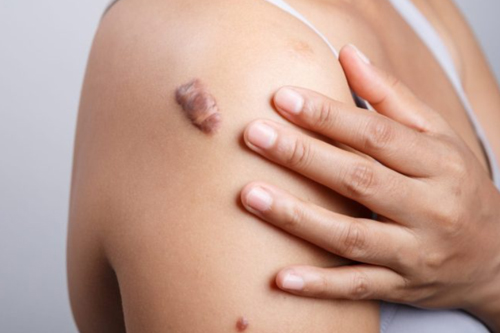
Keloid Treatment In Nagpur is a type of raised and thickened scar that can develop at the site of a wound, injury, or incision. Unlike typical scars that may gradually fade over time, keloids extend beyond the original area of injury and can be larger than the initial wound. they are a form of abnormal wound healing, characterized by the overproduction of collagen.
keloids require intervention, and some individuals may choose to leave them untreated if they are not causing discomfort or functional issues. Keloids are characterized by raised, thick, and often shiny or smooth growths of scar tissue. They can be pink, red, or darker than the surrounding skin.
Symptoms of keloids
Raised and Overgrown Tissue:
- The primary characteristic of keloids is the raised and overgrown appearance of scar tissue. Keloids extend beyond the original boundaries of the wound or injury. Keloid Treatment In Nagpur!
Thickened and Firm Texture:
- Keloids typically have a thickened and firm texture compared to normal skin. The overproduction of collagen contributes to the dense and sometimes rubbery consistency of keloid tissue.
Color Changes:
- Keloids can vary in color, including pink, red, dark brown, or lighter than the surrounding skin. The color may change over time.
Itching (Pruritus):
- Some individuals with keloids may experience itching or a sensation of itching at the site of the scar. Itching is a common symptom, but not everyone with keloids experiences it.
Tenderness or Discomfort:
- Keloids may be tender or cause discomfort, especially if they are subjected to pressure or friction. However, not all keloids are painful.
Growth Beyond Wound Boundaries:
- Unlike normal scars that gradually fade, keloids extend beyond the edges of the original wound. The growth of keloid tissue may continue over time.
Location on High-Tension Areas:
- Keloids often form on areas of the body with little underlying fatty tissue, such as the chest, shoulders, earlobes, and upper back. They may also occur on areas prone to high tension or movement.
Genetic Predisposition:
- Individuals with a family history of keloids may be more prone to developing them. Genetic factors can influence susceptibility to keloid formation.
Treatment Options for Keloids
Diagnosis and Treatment:
- ENT doctors are trained to diagnose and treat various conditions, including ear infections, hearing loss, sinusitis, allergies, throat disorders, voice problems, and head and neck tumors.
Medical and Surgical Interventions:
- They can provide medical interventions such as prescribing medications, managing infections, and recommending therapies. Additionally, they are skilled in performing surgical procedures when necessary, such as ear surgeries, sinus surgery, tonsillectomies, and head and neck surgeries.
Hearing and Balance Disorders:
- ENT specialists are often involved in the diagnosis and management of hearing and balance disorders. They may work closely with audiologists to assess hearing loss and provide appropriate interventions.
Allergies and Respiratory Conditions:
- Conditions related to allergies, nasal congestion, and respiratory problems fall within the scope of an ENT doctor. They can offer treatments for chronic sinusitis, nasal polyps, and other allergic or inflammatory conditions.
Voice and Swallowing Disorders:
- ENT doctors are experts in diagnosing and treating voice and swallowing disorders. They may work with speech therapists to help individuals with these conditions.
Head and Neck Cancer:
- Otolaryngologists play a crucial role in the diagnosis and treatment of head and neck cancers. They may work collaboratively with oncologists and other specialists to develop comprehensive treatment plans.
Pediatric ENT:
- Some ENT doctors specialize in pediatric otolaryngology, focusing on the unique ear, nose, and throat issues that affect children.
Benefits for keloids
Cosmetic Improvement:
- Keloids can be cosmetically bothersome, especially when they are prominent or located in visible areas. Treatment options aim to improve the appearance of keloids, potentially leading to a smoother and less raised scar. Keloid Treatment In Nagpur for More Info Contcat us !
Reduced Itching and Tenderness:
- Keloids can be associated with symptoms such as itching or tenderness. Treatment may help alleviate these symptoms, improving overall comfort.
Enhanced Skin Texture:
- Certain treatments, such as laser therapy or surgical excision followed by other interventions, aim to promote a more even skin texture. This can contribute to improved aesthetics in the treated area.
Improved Self-Image and Confidence:
- Addressing keloids may lead to improved self-image and confidence, particularly if the keloids are in visible areas of the body. Cosmetic concerns related to this can impact an individual’s perception of their appearance.
Prevention of Further Growth:
- Some treatment modalities, such as corticosteroid injections or radiation therapy after surgical excision, aim to prevent or minimize the recurrence of keloids. This is particularly important for individuals prone to keloid formation.
Enhanced Comfort with Clothing and Accessories:
- Keloids in areas prone to friction, such as the earlobes, can cause discomfort when wearing certain accessories or clothing. Treatment may improve comfort and allow individuals to wear accessories without irritation.
